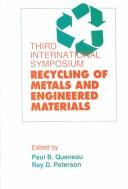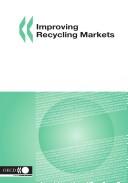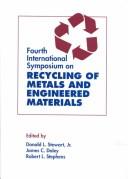| Listing 1 - 10 of 14 | << page >> |
Sort by
|
Book
ISBN: 9264301011 9264301003 Year: 2018 Publisher: Paris : OECD,
Abstract | Keywords | Export | Availability | Bookmark
 Loading...
Loading...Choose an application
- Reference Manager
- EndNote
- RefWorks (Direct export to RefWorks)
Plastics have become one of the most prolific materials on the planet: in 2015 we produced about 380 million tonnes of plastics globally, up from 2 million tonnes in the 1950s. Yet today only 15% of this plastic waste is collected and recycled into secondary plastics globally each year. This report looks at why this is the case and what we can do about it, as the pervasiveness of plastics is becoming an urgent public health and planetary problem. Not only is the diffusion of waste plastics into the wider environment creating hugely negative impacts, but plastics production emits approximately 400 million tonnes of greenhouse gas (GHG) emissions annually as a result of the energy used in their production, transport, and final waste treatment. Improved plastics collection and recycling represents a promising solution to these concerns.
Recycled products. --- Recycled commercial products --- Recycled consumer goods --- Recycled goods --- Recycled manufactures --- Secondary materials (Recycled products) --- Commercial products --- Green products --- Economics --- Business & Economics
Book
ISBN: 9811684251 981168426X Year: 2022 Publisher: Singapore : Springer,
Abstract | Keywords | Export | Availability | Bookmark
 Loading...
Loading...Choose an application
- Reference Manager
- EndNote
- RefWorks (Direct export to RefWorks)

ISBN: 087339318X 9780873393188 Year: 1995 Publisher: Warrendale, Pa.: Minerals metals & materials society,
Abstract | Keywords | Export | Availability | Bookmark
 Loading...
Loading...Choose an application
- Reference Manager
- EndNote
- RefWorks (Direct export to RefWorks)
Scrap metals --- Recycled products --- Recycling --- Congresses --- Metals, Scrap --- Secondary metals --- Swarf (Metal-cutting) --- Salvage (Waste, etc.) --- Scrap materials --- Waste products --- Metals --- Recycled commercial products --- Recycled consumer goods --- Recycled goods --- Recycled manufactures --- Secondary materials (Recycled products) --- Commercial products --- Green products --- Recycling&delete& --- Conservation --- Congresses. --- Scrap metals - Recycling - Congresses --- Recycled products - Congresses

ISBN: 1281747246 9786611747244 9264029583 9264029575 9789264029576 Year: 2006 Publisher: Paris : OECD,
Abstract | Keywords | Export | Availability | Bookmark
 Loading...
Loading...Choose an application
- Reference Manager
- EndNote
- RefWorks (Direct export to RefWorks)
Markets for many classes of potentially recyclable materials are growing. However, market failures and barriers are constraining some markets. Factors such as information failures, technological externalities, and market power can affect the prices, quantity, and quality of materials traded. This report presents the case for the use of 'industrial' policies which address such market failures and barriers and these policies are seen as complements to more traditional environmental policies. Indeed, encouraging ever-higher recycling rates in the absence of such complementary measures may impose very high social welfare costs. This publication covers in particular the markets for waste oils, waste plastics, and used rubber tyres.
Recycled products. --- Recycling (Waste, etc.). --- Refuse and refuse disposal. --- Recycling (Waste, etc.) --- Recycled products --- Civil & Environmental Engineering --- Engineering & Applied Sciences --- Environmental Engineering --- Recycled commercial products --- Recycled consumer goods --- Recycled goods --- Recycled manufactures --- Secondary materials (Recycled products) --- Conversion of waste products --- Recovery of natural resources --- Recovery of waste materials --- Resource recovery --- Waste recycling --- Waste reuse --- Commercial products --- Green products --- Conservation of natural resources --- Refuse and refuse disposal --- Energy conservation --- Salvage (Waste, etc.) --- Waste products --- Recyclage (Déchets, etc.) --- Produits recyclés
Book
ISBN: 0444642838 0444642005 9780444642837 9780444642004 Year: 2019 Publisher: St. Louis, Missouri : Elsevier,
Abstract | Keywords | Export | Availability | Bookmark
 Loading...
Loading...Choose an application
- Reference Manager
- EndNote
- RefWorks (Direct export to RefWorks)
Sustainable Resource Recovery and Zero Waste Approaches covers waste reduction, biological, thermal and recycling methods of waste recovery, and their conversion into a variety of products. In addition, the social, economic and environmental aspects are also explored, making this a useful textbook for environmental courses and a reference book for both universities and companies.
Waste minimization. --- Refuse and refuse disposal. --- Recycled products. --- Recycled commercial products --- Recycled consumer goods --- Recycled goods --- Recycled manufactures --- Secondary materials (Recycled products) --- Commercial products --- Green products --- Discarded materials --- Disposal of refuse --- Garbage --- Household waste --- Household wastes --- Refuse and refuse disposal --- Rubbish --- Solid waste management --- Trash --- Waste disposal --- Waste management --- Wastes, Household --- Sanitation --- Factory and trade waste --- Pollution --- Pollution control industry --- Salvage (Waste, etc.) --- Street cleaning --- Waste products --- Minimization of waste --- Reduction of waste --- Waste reduction --- Conservation of natural resources --- Pollution prevention --- Environmental aspects
Book
ISBN: 1786997398 178699738X 9781786997395 9781786997388 9781786997401 1786997401 9781786997371 135021924X 1786997371 Year: 2019 Publisher: London: Zed books,
Abstract | Keywords | Export | Availability | Bookmark
 Loading...
Loading...Choose an application
- Reference Manager
- EndNote
- RefWorks (Direct export to RefWorks)
Following a pair of jeans, Clothing Poverty takes the reader on a vivid around-the-world tour to reveal how clothes are manufactured and retailed, bringing to light how fast fashion and clothing recycling are interconnected. Andrew Brooks shows how recycled clothes are traded across continents, uncovers how retailers and international charities are embroiled in commodity chains which perpetuate poverty, and exposes the hidden trade networks which transect the globe. Stitching together rich narratives, from Mozambican markets, Nigerian smugglers and Chinese factories to London's vintage clothing scene, TOMS shoes and Vivienne Westwood's ethical fashion lines, Brooks uncovers the many hidden sides of fashion.--Cover.
Clothing trade --- Apparel industry --- Clothiers --- Clothing industry --- Fashion industry --- Garment industry --- Rag trade --- Textile industry --- Tailors --- Used clothing industry --- Poverty --- Destitution --- Wealth --- Basic needs --- Begging --- Poor --- Subsistence economy --- Secondhand trade --- Economic aspects --- Moral and ethical aspects --- E-books --- Poverty. --- Recycled products. --- Recycled commercial products --- Recycled consumer goods --- Recycled goods --- Recycled manufactures --- Secondary materials (Recycled products) --- Commercial products --- Green products --- Economic aspects. --- Moral and ethical aspects. --- Recycled products --- Clothing trade - Economic aspects - Developing countries --- Used clothing industry - Economic aspects - Developing countries --- Fashion & society
Book
ISBN: 0323909833 9780323909839 9780323909822 0323909825 Year: 2022 Publisher: Amsterdam, Netherlands ; Kidlington, Oxford ; Cambridge, Massachusetts : Elsevier,
Abstract | Keywords | Export | Availability | Bookmark
 Loading...
Loading...Choose an application
- Reference Manager
- EndNote
- RefWorks (Direct export to RefWorks)
"Nanomaterial Recycling provides an update on the many benefits nanomaterials can provide on both environmental and economic issues. Sections cover the appropriate recycling strategies of nanowastes, nanowaste regulations (including nanowaste disposal and recycling standards), promising applications (reuses) of these recycled nanomaterials, and various methods used for the separation of nanoparticles, including (i) centrifugation, (ii)solvent evaporation, (iii) magnetic separation, (iv) using pH/thermal responsive materials, (v) molecular antisolvents, (vi) nanostructured colloidal solvents, and more. This book is an important reference source for materials scientists and engineers who are seeking to increase their understanding of nanomaterials, recycling processes and techniques."--
Nanostructured materials. --- Recycling (Waste, etc.) --- Recycled products. --- Recycled commercial products --- Recycled consumer goods --- Recycled goods --- Recycled manufactures --- Secondary materials (Recycled products) --- Commercial products --- Green products --- Conversion of waste products --- Recovery of natural resources --- Recovery of waste materials --- Resource recovery --- Waste recycling --- Waste reuse --- Conservation of natural resources --- Refuse and refuse disposal --- Energy conservation --- Salvage (Waste, etc.) --- Waste products --- Nanomaterials --- Nanometer materials --- Nanophase materials --- Nanostructure controlled materials --- Nanostructure materials --- Ultra-fine microstructure materials --- Microstructure --- Nanotechnology --- Nanostructured materials --- Nanostructures --- Recycling --- Recycling. --- Nanostructures.

ISBN: 0873394941 9780873394949 Year: 2000 Publisher: Warrendale: Minerals metals & materials society,
Abstract | Keywords | Export | Availability | Bookmark
 Loading...
Loading...Choose an application
- Reference Manager
- EndNote
- RefWorks (Direct export to RefWorks)
669.054.8 --- Utilization of scrap, waste products. Generalities on the recovery of metals from scrap. Separation of alloy components --- Scrap metals --- Recycled products --- Recycling --- 669.054.8 Utilization of scrap, waste products. Generalities on the recovery of metals from scrap. Separation of alloy components --- Metals, Scrap --- Secondary metals --- Swarf (Metal-cutting) --- Salvage (Waste, etc.) --- Scrap materials --- Waste products --- Metals --- Recycled commercial products --- Recycled consumer goods --- Recycled goods --- Recycled manufactures --- Secondary materials (Recycled products) --- Commercial products --- Green products --- Conservation --- Scrap metals - Recycling - Congresses --- Recycled products - Congresses
Book
ISBN: 9783319151830 3319151827 9783319151823 3319151835 Year: 2015 Publisher: Cham : Springer International Publishing : Imprint: Springer,
Abstract | Keywords | Export | Availability | Bookmark
 Loading...
Loading...Choose an application
- Reference Manager
- EndNote
- RefWorks (Direct export to RefWorks)
This book presents a number of aspects to be considered in the development of disassembly automation, including the mechanical system, vision system and intelligent planner. The implementation of cognitive robotics increases the flexibility and degree of autonomy of the disassembly system. Disassembly, as a step in the treatment of end-of-life products, can allow the recovery of embodied value left within disposed products, as well as the appropriate separation of potentially-hazardous components. In the end-of-life treatment industry, disassembly has largely been limited to manual labor, which is expensive in developed countries. Automation is one possible solution for economic feasibility. The target audience primarily comprises researchers and experts in the field, but the book may also be beneficial for graduate students.
Engineering. --- Robotics and Automation. --- Manufacturing, Machines, Tools. --- Sustainable Development. --- Innovation/Technology Management. --- Machinery. --- Sustainable development. --- Ingénierie --- Machines --- Développement durable --- Recycled products. --- Recycling industry -- Automation. --- Mechanical Engineering --- Engineering & Applied Sciences --- Mechanical Engineering - General --- Recycling industry --- Automation. --- Recycled commercial products --- Recycled consumer goods --- Recycled goods --- Recycled manufactures --- Secondary materials (Recycled products) --- Management. --- Industrial management. --- Robotics. --- Manufacturing industries. --- Machines. --- Tools. --- Commercial products --- Green products --- Pollution control industry --- Manufactures. --- Manufacturing, Machines, Tools, Processes. --- Administration --- Industrial relations --- Organization --- Development, Sustainable --- Ecologically sustainable development --- Economic development, Sustainable --- Economic sustainability --- ESD (Ecologically sustainable development) --- Smart growth --- Sustainable development --- Sustainable economic development --- Economic development --- Manufactured goods --- Manufactured products --- Products --- Products, Manufactured --- Manufacturing industries --- Environmental aspects --- Business administration --- Business enterprises --- Business management --- Corporate management --- Corporations --- Industrial administration --- Management, Industrial --- Rationalization of industry --- Scientific management --- Management --- Business --- Industrial organization --- Automatic factories --- Automatic production --- Computer control --- Engineering cybernetics --- Factories --- Industrial engineering --- Mechanization --- Assembly-line methods --- Automatic control --- Automatic machinery --- CAD/CAM systems --- Robotics --- Automation --- Machine theory
Book
ISBN: 9781138081017 9781315113067 Year: 2019 Publisher: London Routledge, Taylor & Francis Group
Abstract | Keywords | Export | Availability | Bookmark
 Loading...
Loading...Choose an application
- Reference Manager
- EndNote
- RefWorks (Direct export to RefWorks)
The circular economy describes a world in which reuse through repair, reconditioning and refurbishment is the prevailing social and economic model. The business opportunities are huge but developing product and service offerings and achieving competitive advantage means rethinking your business model from early creativity and design processes, through marketing and communication to pricing and supply. Designing for the Circular Economy highlights and explores ‘state of the art’ research and industrial practice, highlighting CE as a source of: new business opportunities; radical business change; disruptive innovation; social change; and new consumer attitudes. The thirty-four chapters provide a comprehensive overview of issues related to product circularity from policy through to design and development. Chapters are designed to be easy to digest and include numerous examples. An important feature of the book is the case studies section that covers a diverse range of topics related to CE, business models and design and development in sectors ranging from construction to retail, clothing, technology and manufacturing.Designing for the Circular Economy will inform and educate any companies seeking to move their business models towards these emerging models of sustainability; organizations already working in the circular economy can benchmark their current activities and draw inspiration from new applications and an understanding of the changing social and political context. This book will appeal to both academia and business with an interest in CE issues related to products, innovation and new business models.
Product design --- Recycled products. --- Green products. --- Sustainable development. --- Environmentalism --- Produits commerciaux --- Produits recyclés --- Éco-produits --- Développement durable --- Écologisme. --- Environmental aspects. --- Economic aspects. --- Aspect environnemental --- Éco-produits. --- Economic production --- Production management --- methodology --- designs [artistic concepts] --- sustainable development --- Recycled products --- Sustainable development --- Green products --- Environmental movement --- Social movements --- Anti-environmentalism --- Greenwashing --- Sustainable living --- Earth-friendly products --- Environmentally safe products --- Commercial products --- Green marketing --- Development, Sustainable --- Ecologically sustainable development --- Economic development, Sustainable --- Economic sustainability --- ESD (Ecologically sustainable development) --- Smart growth --- Sustainable economic development --- Economic development --- Recycled commercial products --- Recycled consumer goods --- Recycled goods --- Recycled manufactures --- Secondary materials (Recycled products) --- New products --- Industrial design --- Environmental aspects --- Economic aspects --- Design and construction --- productontwikkeling --- Éco-produits. --- Produits recyclés --- Éco-produits --- Développement durable --- Écologisme.
| Listing 1 - 10 of 14 | << page >> |
Sort by
|

 Search
Search Feedback
Feedback About UniCat
About UniCat  Help
Help News
News